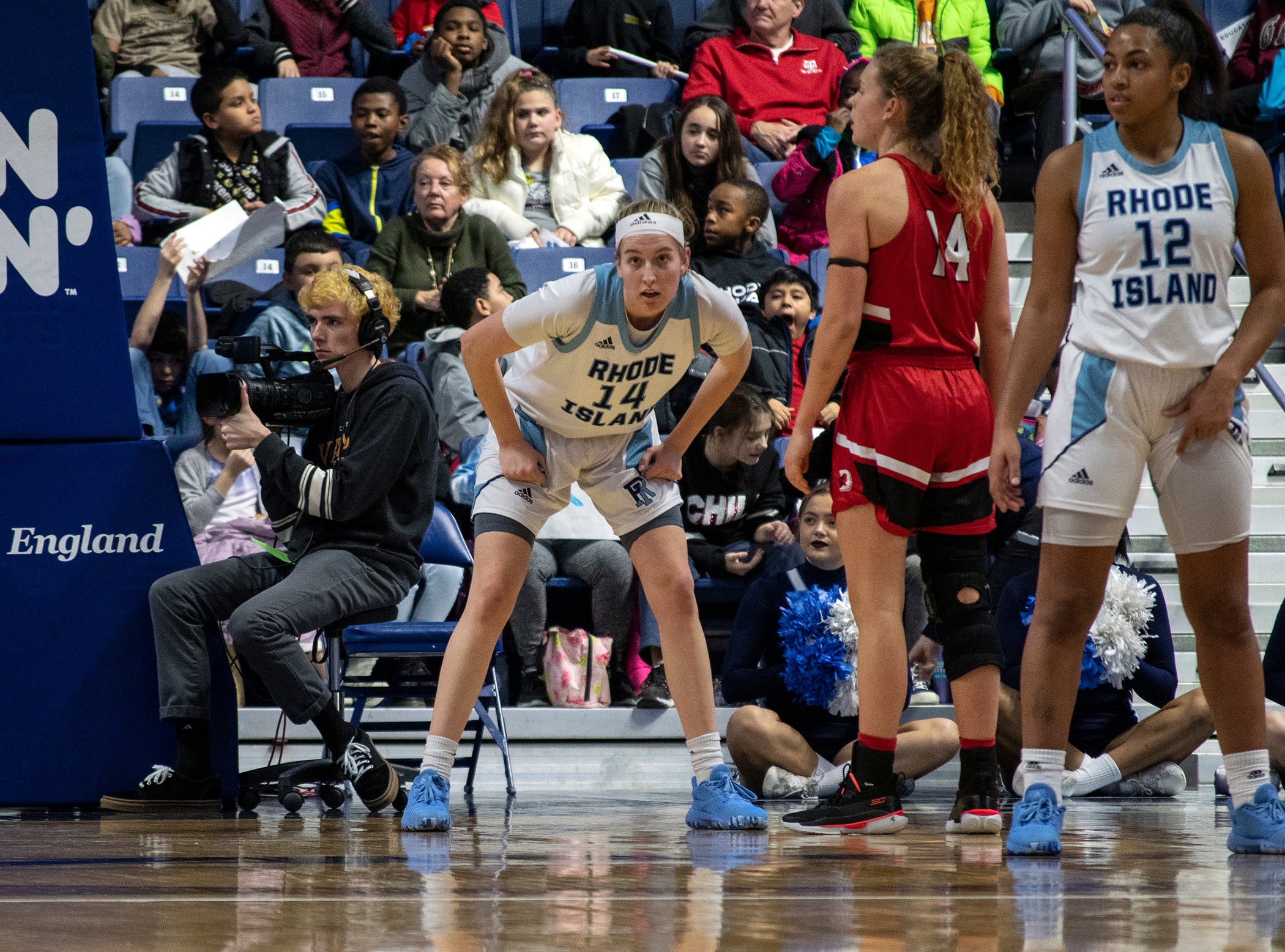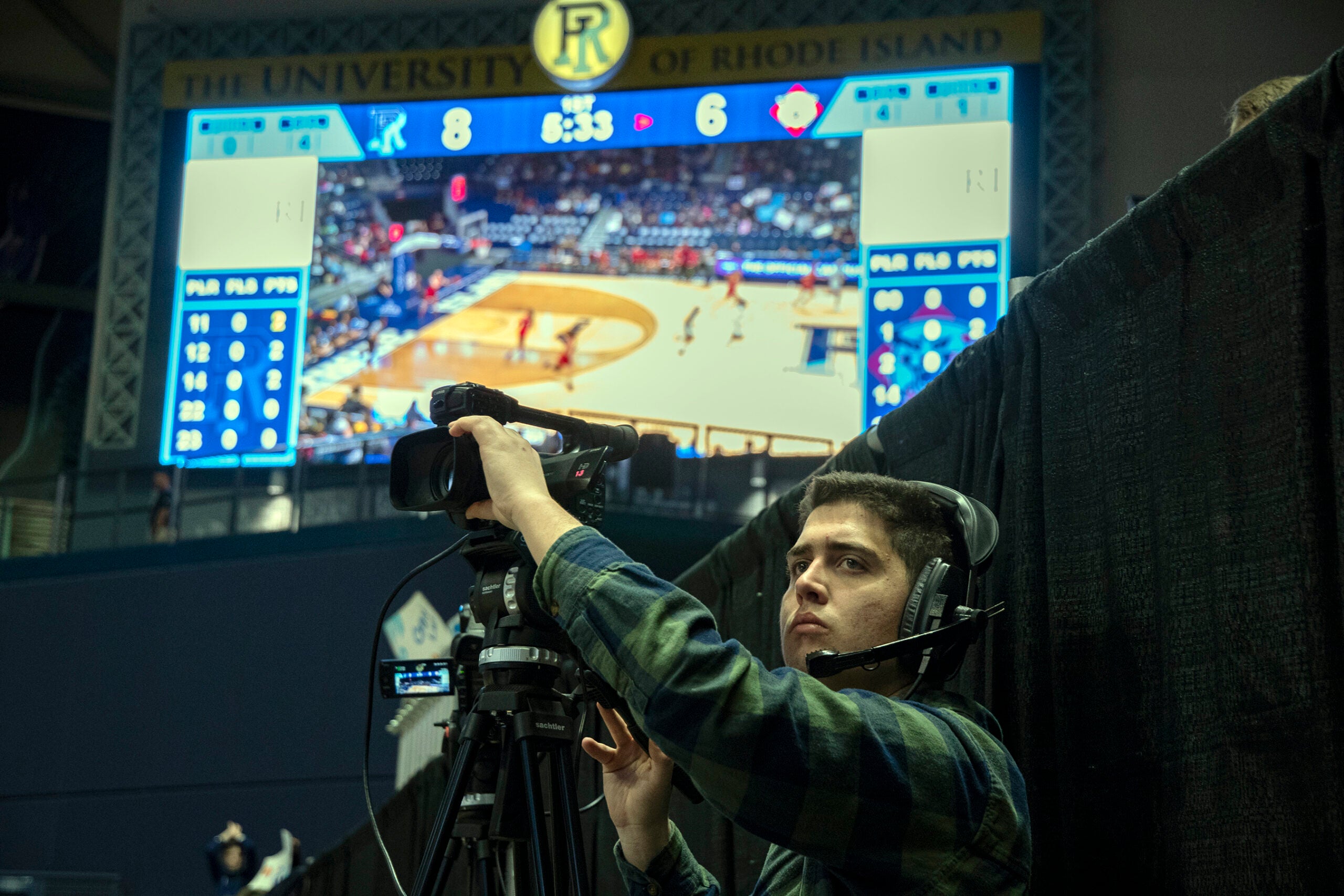KINGSTON, R.I. – Feb. 21, 2020 – Clay Cook’s season highlight is the three-point shot that he completely nailed. Cook’s not a basketball player. He’s a cameraman.
“I was following the shot and I got the entire basket on a half-court shot,” says Cook. “It was all there and they used it for a replay. That was when I knew, this is fun, this is good. It was all worth it.”
Cook ’22, a major in communications and sports media, is one of a half-dozen University of Rhode Island students getting the rare opportunity to work on a professional production crew with Cox Communications to broadcast URI women’s basketball home games.
The opportunity has come thanks to a collaboration between URI Athletics, the University’s Harrington School of Communication and Media, and Cox YurView. URI’s modern, $1.25 million Broadcast Center is a key part of the initiative.

The collaboration has also provided URI women’s basketball with the most extensive coverage in the program’s history. Saturday’s home finale against La Salle will be the 11th women’s game to be shown this season on Cox YurView – Channel 4 – and streamed live nationally on ESPN+. And while women’s home games were previously streamed by URI Athletics using one camera, games now receive a professional level of production.
Each live broadcast is produced out of URI’s new Broadcast Center in the Chafee Social Science Center, and Cox has provided professional replay and graphic technicians and an associate director and director, along with a chief camera operator in the Ryan Center. But the rest of the crew – three more camera operators and a stage manager – are URI students. (Doing the play-by-play is URI alumnus Stone Freeman ’19.)
“This is a terrific partnership. Our students are learning to run sports cameras on the job. They’re being trained by a professional with Cox. And the Broadcast Center has not only risen to the challenge but it’s meeting the challenge and delivering live, professional-quality sports with students as part of the production team,” says Jeff Fountain, manager of the Broadcast Center and TV production instructor. “In the realm of live television, the only two things that really still march on as live are local news and sports. Those are the only two opportunities. The people who can function in that live environment are in high demand.”
“The project has far exceeded any of our expectations,” says Christian Ackerknecht, live event manager for Cox YurView and director, technical director and producer of the URI broadcasts. “Jeff Fountain has done a remarkable job in organizing this project and preparing the students. The shows have progressed dramatically throughout the season. We started simple, evaluating the crew and whatever technical limitations we may run into. The key thing has been that the students came prepared to learn.”
URI’s new Broadcast Center opened in September after a year of renovations, and Fountain, who oversaw renovations, felt it would be at least a year before it would be tested at this level. The center has fiber connections with the Ryan Center, allowing for the sending of audio and video, and Fountain has added graphics and slow-motion replay technology needed to produce live sports programming.
“When we did our first women’s game in November, it remarkably was technically flawless,” says Fountain. “We all looked at each other afterward and said, ‘Holy smoke.’ If you look at it, there’s graphics flying out at you, there’s the clock on the screen, there’s replay, there’s a pregame show. It’s totally pro.”
With the technology in place, the project needed student camera people to make it happen. Fountain recruited students from his TV production classes and from the Harrington School’s new sports media major. Cox cameraman Chuck Murphy has worked with the students to get them ready to shoot live sports.
“Chuck works all the ‘big’ shows in New England, including the Patriots, Red Sox and Bruins,” says Ackerknecht. “He was immediately impressed with the professional attitude of the students and how quickly they were able to learn and improve.”
For Brendan Bennett ’21, a film media major, the biggest learning curve was getting a feel for the flow of the game. He had worked with cameras in a production class, and Murphy gave him a walk through on game cameras and an idea of what to look for during games.
“I haven’t watched too much basketball before this,” says Bennett, of Middletown. “So, the first game on a new camera, I’m learning what I should be capturing. The second game, I’m pretty comfortable, and third game, I’m experimenting, finding more interesting shots.”
Bennett also puts in time studying previous games in the control room, learning what he can do better. “When I’m on the court, I’m getting less than a quarter of the whole show,” he says. “Seeing the whole thing put together with the three other cameras, graphics and the commentator helps me see how my camera fits in.”
Bennett has worked a camera for 10 of the 13 URI games Cox has broadcast this season – including two men’s basketball games. He usually is stationed under the basket, catching the action on a swivel stool. “I get free throws if they’re shooting at my basket,” he says. “The main two cameras are up top – the camera that provides the wide shot viewers see about 80% of the time and the camera that gets the ‘hero shot’ when someone scores. I’m there mainly for auxiliary footage – after a whistle if someone gets knocked down or reactions from the URI bench in between action.”
Clay Cook started on the “hero cam” and has worked three of the four cameras stationed around the Ryan Center. The East Providence resident started the season with “zero” experience and learned by shooting warmups. But six games in – with the Cox cameraman not available – Cook was called on to work the main camera that provides viewers the majority of the game action. It’s another of his highlights this season.
“For someone who had no experience six games before and then being able to do that,” he says, “I thought the entire game looked good and crisp.”
For Mason Belcher, working the games has changed the way he watches sports. “I’ve started noticing the different angles and cuts from cameras while watching basketball games,” says Belcher ’21, a major in film media and communications. “I have a better understanding of how they film these games.”
“This has been a great opportunity,” adds the Scituate resident. “I’ve learned a lot from working with professionals and they’ve passed on knowledge about working in live television. Gaining hands-on experience with film and media in college is very important.”
For Cook and Bennett, it’s also allowed them to explore the many career options available in sports communications.
Besides working cameras, Bennett is one of several students to work in the control room. His goal is to work as the technical director, queuing up the camera shots that Ackerknecht calls out. “Technical directing appeals to me because it’s fun and challenging,” says Bennett. “It requires a good bit of knowledge about every component of the studio and is one of the most active roles.”
Cook, who envisioned doing sports play-by-play when he was growing up, now sees opportunities behind the scenes. “Hearing the director and knowing what goes on behind the scenes, the idea of being a director for a live sports show sounds more appealing to me. I don’t think that’s something I would have ever thought about.”
In the future, there is a chance for more opportunities for students. The University plans to add fiber connections to fields around the Ryan Center and expanding live streaming to soccer, baseball, softball and volleyball, says Shane Donaldson, assistant athletic director for media relations. “Eventually the hope is for Cox to add to what is televised,” he says, “but either way, the sports will be streamed on ESPN+ to a nationwide audience.”
The $1.25 million in renovations to the Harrington School’s Broadcast Center were made possible by grants from the Champlin Foundation and the URI Provost’s Office, along with private donations from prominent donors Richard and Jean Harrington, and Herman Rose, along with other members of the Harrington School Advisory Board.

